
Industrial products distributor Applied Industrial (NYSE:AIT) met Wall Street’s revenue expectations in Q1 CY2025, with sales up 1.8% year on year to $1.17 billion. Its GAAP profit of $2.57 per share was 6.6% above analysts’ consensus estimates.
Is now the time to buy Applied Industrial? Find out by accessing our full research report, it’s free.
Applied Industrial (AIT) Q1 CY2025 Highlights:
- Revenue: $1.17 billion vs analyst estimates of $1.17 billion (1.8% year-on-year growth, in line)
- EPS (GAAP): $2.57 vs analyst estimates of $2.41 (6.6% beat)
- Adjusted EBITDA: $144.9 million vs analyst estimates of $142 million (12.4% margin, 2.1% beat)
- EPS (GAAP) guidance for the full year is $9.93 at the midpoint, roughly in line with what analysts were expecting
- Operating Margin: 11.1%, in line with the same quarter last year
- Free Cash Flow Margin: 10.5%, up from 6.7% in the same quarter last year
- Organic Revenue fell 3.1% year on year (-0.1% in the same quarter last year)
- Market Capitalization: $9.34 billion
Neil A. Schrimsher, Applied’s President & Chief Executive Officer, commented, “We delivered another quarter of strong operational performance. EBITDA and EPS exceeded our expectations, increasing 7% and 4%, respectively, over the prior year on 2% sales growth. Our Applied team did an outstanding job managing through ongoing demand weakness and macro uncertainty with the average daily sales organic decline of 3% holding relatively steady with last quarter and within our guidance. In addition, gross margins and EBITDA margins expanded nicely, further reflecting internal initiatives, channel execution, mix tailwinds, and solid cost management. We also achieved record third quarter cash generation and increased our share repurchase activity. Lastly, I am pleased with the early progress of our recent acquisition of Hydradyne with integration ongoing and financial contribution expected to increase in coming quarters.”
Company Overview
Formerly called The Ohio Ball Bearing Company, Applied Industrial (NYSE:AIT) distributes industrial products–everything from power tools to industrial valves–and services to a wide variety of industries.
Sales Growth
A company’s long-term performance is an indicator of its overall quality. Any business can experience short-term success, but top-performing ones enjoy sustained growth for years. Unfortunately, Applied Industrial’s 5.7% annualized revenue growth over the last five years was tepid. This was below our standard for the industrials sector and is a tough starting point for our analysis.
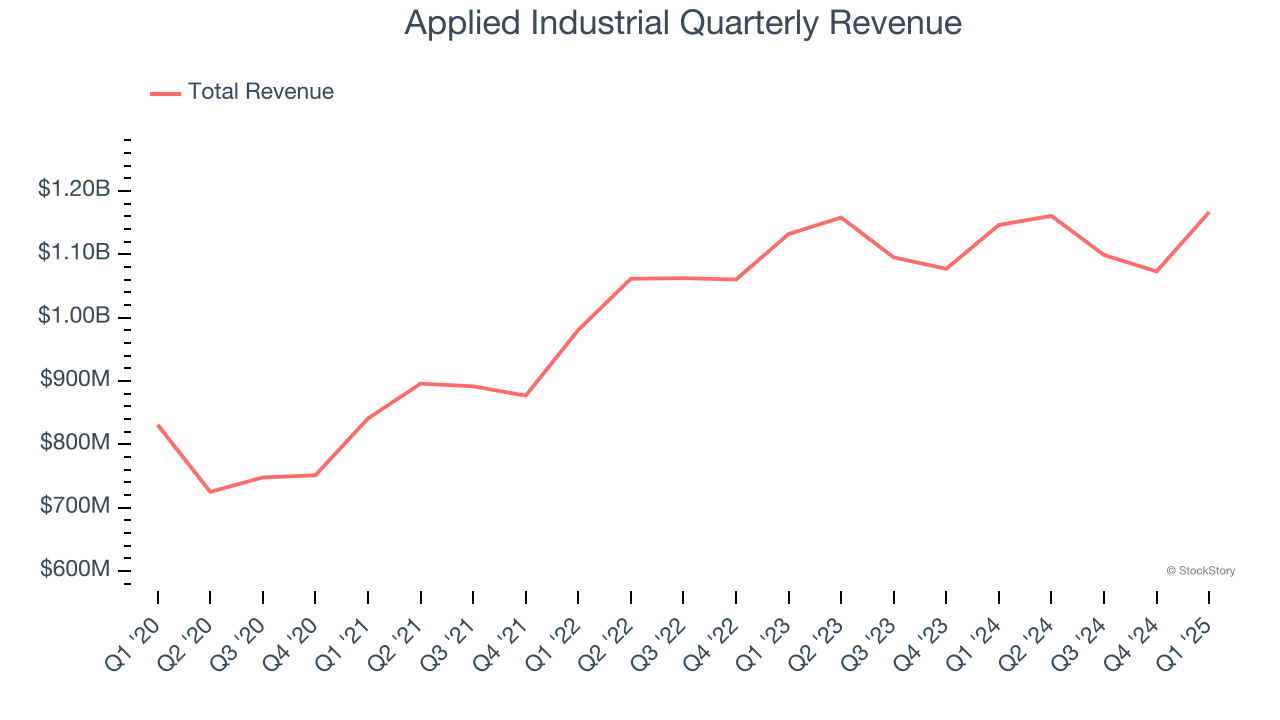
Long-term growth is the most important, but within industrials, a half-decade historical view may miss new industry trends or demand cycles. Applied Industrial’s recent performance shows its demand has slowed as its annualized revenue growth of 2.1% over the last two years was below its five-year trend. 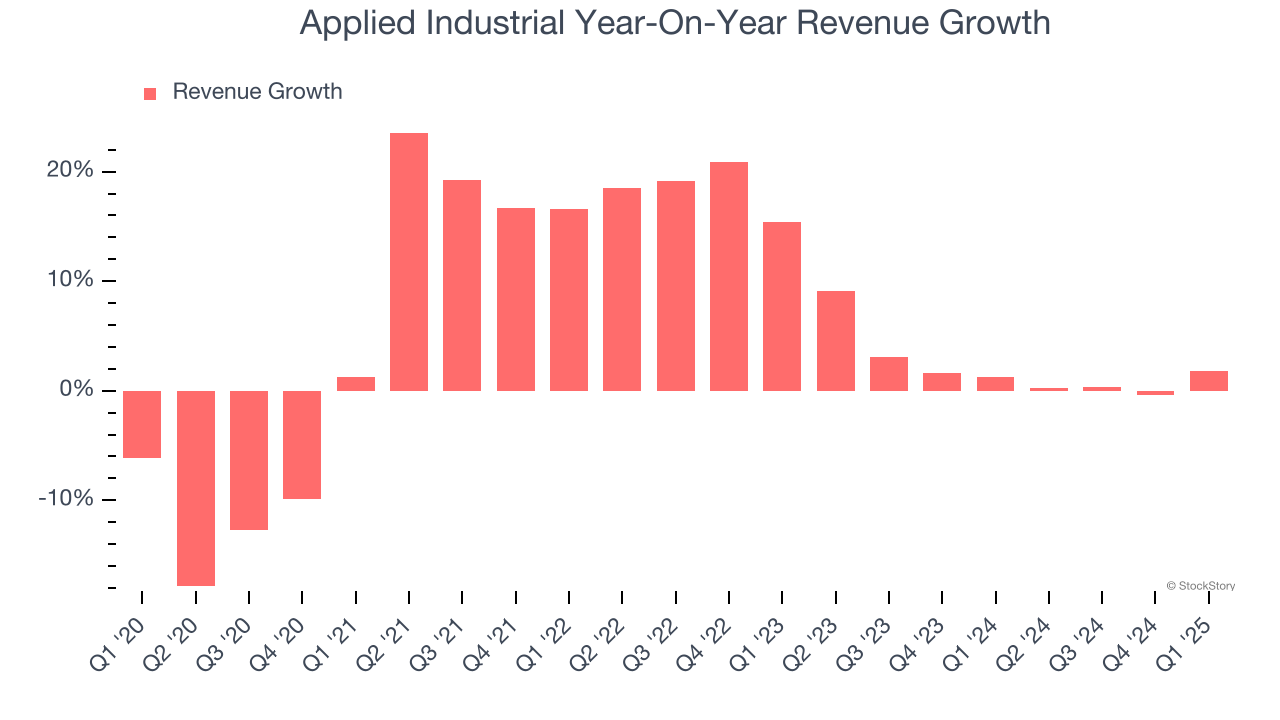
We can dig further into the company’s sales dynamics by analyzing its organic revenue, which strips out one-time events like acquisitions and currency fluctuations that don’t accurately reflect its fundamentals. Over the last two years, Applied Industrial’s organic revenue was flat. Because this number is lower than its normal revenue growth, we can see that some mixture of acquisitions and foreign exchange rates boosted its headline results. 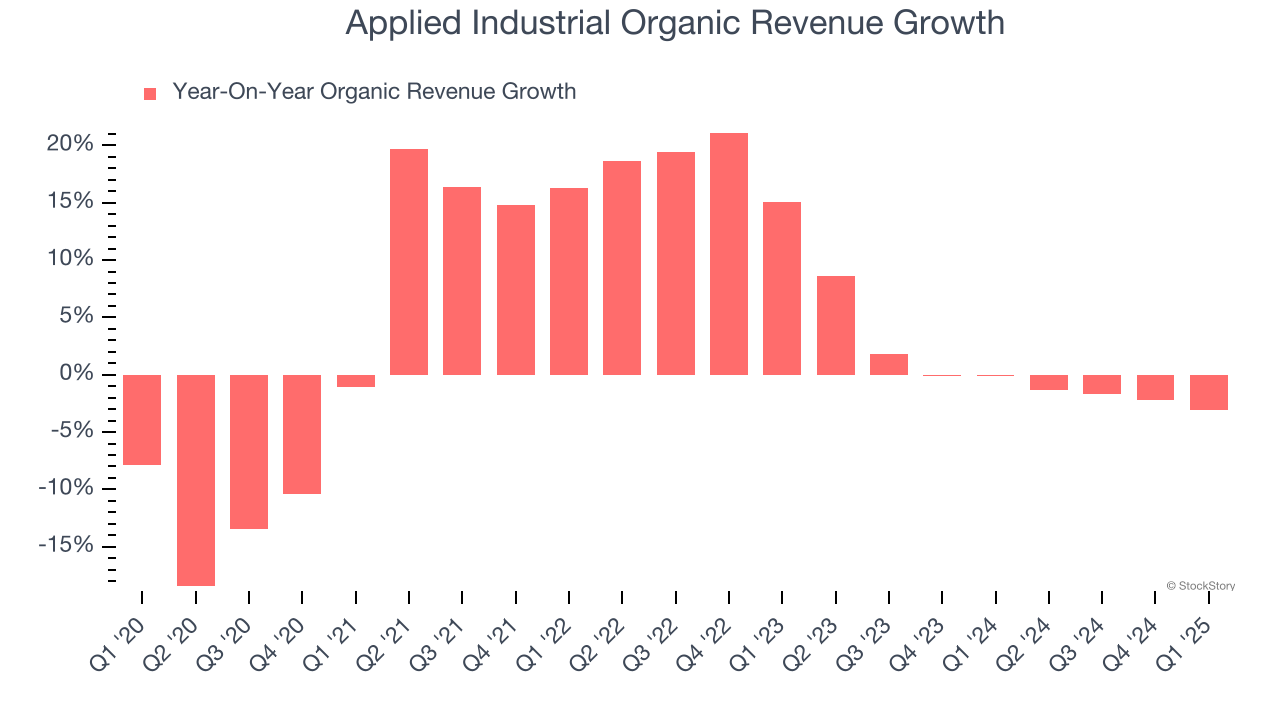
This quarter, Applied Industrial grew its revenue by 1.8% year on year, and its $1.17 billion of revenue was in line with Wall Street’s estimates.
Looking ahead, sell-side analysts expect revenue to grow 8% over the next 12 months, an improvement versus the last two years. This projection is above average for the sector and indicates its newer products and services will spur better top-line performance.
Here at StockStory, we certainly understand the potential of thematic investing. Diverse winners from Microsoft (MSFT) to Alphabet (GOOG), Coca-Cola (KO) to Monster Beverage (MNST) could all have been identified as promising growth stories with a megatrend driving the growth. So, in that spirit, we’ve identified a relatively under-the-radar profitable growth stock benefiting from the rise of AI, available to you FREE via this link.
Operating Margin
Applied Industrial has managed its cost base well over the last five years. It demonstrated solid profitability for an industrials business, producing an average operating margin of 10%. This result was particularly impressive because of its low gross margin, which is mostly a factor of what it sells and takes huge shifts to move meaningfully. Companies have more control over their operating margins, and it’s a show of well-managed operations if they’re high when gross margins are low.
Looking at the trend in its profitability, Applied Industrial’s operating margin rose by 3.8 percentage points over the last five years, as its sales growth gave it operating leverage.
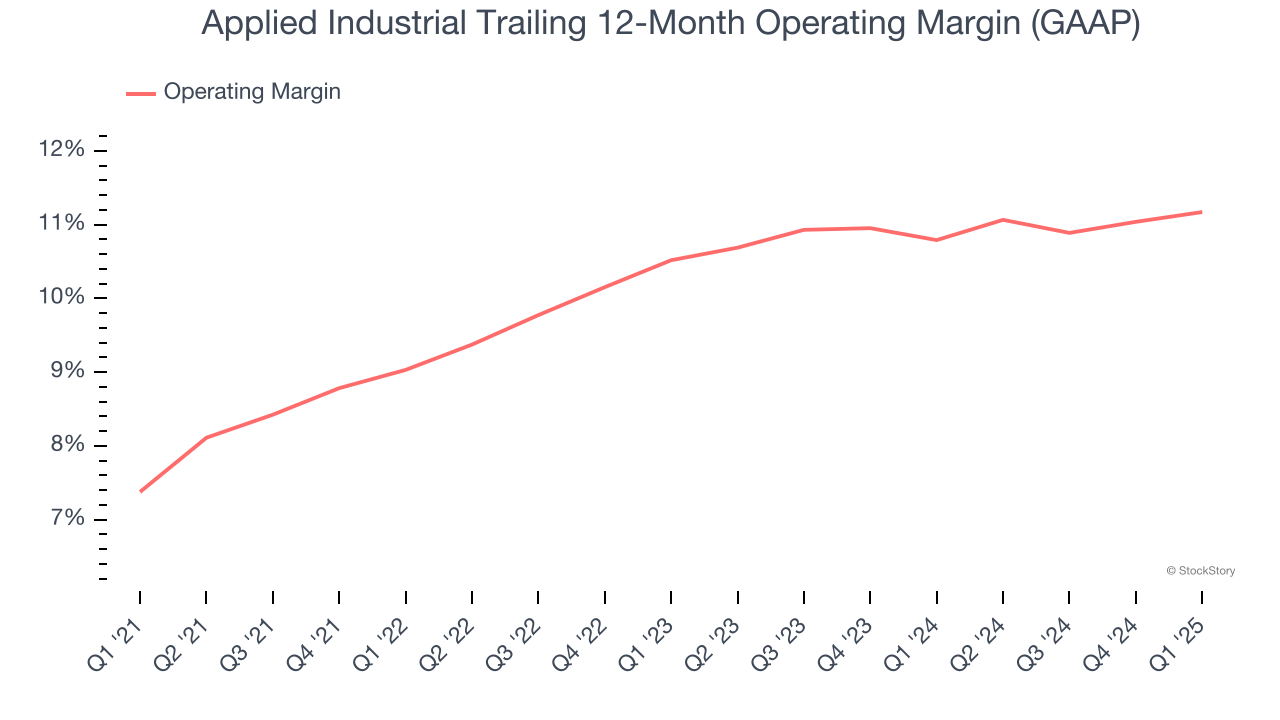
This quarter, Applied Industrial generated an operating profit margin of 11.1%, in line with the same quarter last year. This indicates the company’s cost structure has recently been stable.
Earnings Per Share
Revenue trends explain a company’s historical growth, but the long-term change in earnings per share (EPS) points to the profitability of that growth – for example, a company could inflate its sales through excessive spending on advertising and promotions.
Applied Industrial’s EPS grew at an astounding 63.6% compounded annual growth rate over the last five years, higher than its 5.7% annualized revenue growth. This tells us the company became more profitable on a per-share basis as it expanded.
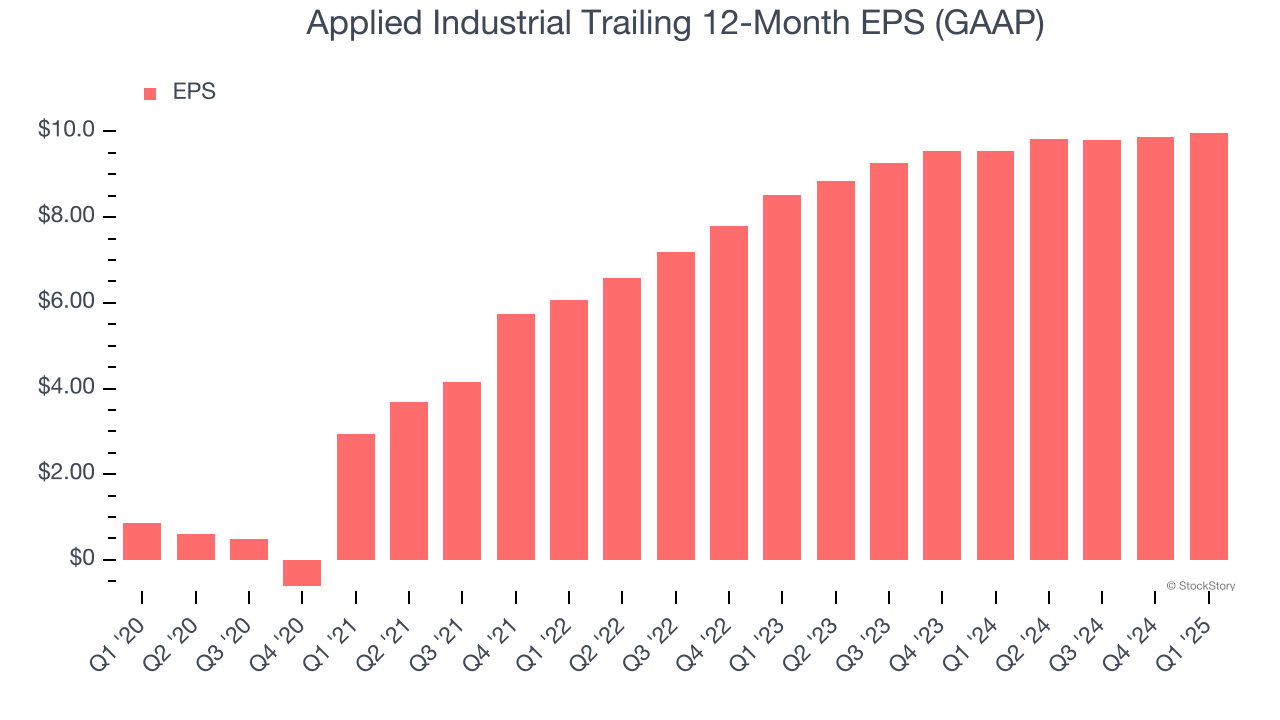
We can take a deeper look into Applied Industrial’s earnings to better understand the drivers of its performance. As we mentioned earlier, Applied Industrial’s operating margin was flat this quarter but expanded by 3.8 percentage points over the last five years. This was the most relevant factor (aside from the revenue impact) behind its higher earnings; taxes and interest expenses can also affect EPS but don’t tell us as much about a company’s fundamentals.
Like with revenue, we analyze EPS over a shorter period to see if we are missing a change in the business.
For Applied Industrial, its two-year annual EPS growth of 8.2% was lower than its five-year trend. We hope its growth can accelerate in the future.
In Q1, Applied Industrial reported EPS at $2.57, up from $2.48 in the same quarter last year. This print beat analysts’ estimates by 6.6%. Over the next 12 months, Wall Street expects Applied Industrial’s full-year EPS of $9.97 to grow 7.3%.
Key Takeaways from Applied Industrial’s Q1 Results
It was encouraging to see Applied Industrial beat analysts’ EBITDA expectations this quarter. We were also happy its EPS outperformed Wall Street’s estimates. On the other hand, its revenue was in line. Overall, this quarter had some key positives. The stock remained flat at $243.13 immediately after reporting.
Should you buy the stock or not? What happened in the latest quarter matters, but not as much as longer-term business quality and valuation, when deciding whether to invest in this stock. We cover that in our actionable full research report which you can read here, it’s free.
